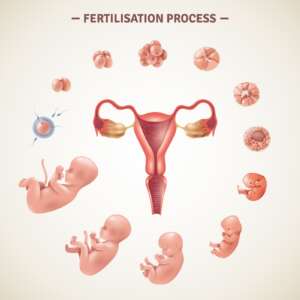
Hi, and welcome! Here is Dr. Santoshi Nandigam, a gynecologist consultant at Chennai’s The Birthwave Clinic.
One of the most frequent (and intriguing) questions I receive from expectant mothers is:
“How does my uterus change during pregnancy?”
In this blog, we’ll explore the uterus pregnancy journey, showing how your uterus develops, expands, and gracefully transforms from the size of a tiny pear to holding a mature baby. This amazing change gives us valuable insight into your pregnancy’s progress.
The Uterus at Rest Before Pregnancy
Before the uterus pregnancy journey begins, the uterus is a tiny, muscular, pear-shaped organ located deep within the pelvis. It weighs about 60 grams and is about 7–8 cm long, neatly tucked behind the bladder.
Despite its small size, this powerful organ is ready to become the centerpiece of pregnancy transformation.
Weeks 1–12 of the First Trimester: Unseen Changes Start
During the first trimester of your uterus pregnancy journey, most changes occur internally.
Weeks 6–8: The uterus enlarges, resembling a goose egg or small orange.
By Week 12: It rises above the pubic bone and can be felt through the lower abdomen.
If you’re carrying twins or multiples, the uterus may expand more quickly in early pregnancy.
Even when changes aren’t visible externally, your uterus is already working hard to expand the uterine cavity to support your baby.
Weeks 13–26 of the Second Trimester: You’re Now Pregnant!
This is the stage where many women start to “show” in their uterus pregnancy journey.
16 weeks: The uterus sits midway between your navel and pubic bone.
20 weeks: It reaches your belly button.
24–26 weeks: The uterus extends several centimeters above the navel.
Your gynecologist will measure fundal height — the distance from your pubic bone to the top of your uterus.
Pro tip: After 20 weeks, fundal height in centimeters usually matches the pregnancy week. For example, 28 cm corresponds to 28 weeks.
Monitoring this growth is vital in the uterus pregnancy journey, as it helps detect issues like IUGR (intrauterine growth restriction) or excess amniotic fluid.
Weeks 27–40 of the Third Trimester: The Uterus at Full Capacity
By the third trimester, your uterus reaches its peak in the uterus pregnancy journey:
36 weeks: Uterus size increases nearly 500 times!
40 weeks: Fundal height may measure 36–40 cm.
As your baby prepares for birth, the uterus supports:
The placenta
Amniotic fluid
Increased blood flow
Stronger uterine walls for contractions
Around the last weeks, “lightening” occurs as the baby drops lower into the pelvis, sometimes lowering fundal height slightly.

The Significance of Monitoring Fundal Height
At The Birthwave Clinic, we use fundal height as a non-invasive method to monitor your uterus pregnancy journey and evaluate:
-
Fetal growth
-
Amniotic fluid levels
-
Conditions like macrosomia (large baby) or IUGR
-
The need for additional scans
A variance of ±2 cm is typically normal, but your gynecologist may order more tests if your uterus measures too big or small.
The Uterus Reverts to Its Initial Size After Delivery
The uterus pregnancy journey doesn’t end at childbirth. After delivery, your uterus undergoes involution, shrinking back to its pre-pregnancy size:
-
Day 1 postpartum: Felt at or slightly below your belly button.
-
By Weeks 6–7: Returns to original weight and shape.
Mild cramping may occur during breastfeeding due to oxytocin helping the uterus contract.
Weekly Uterus Pregnancy Size Chart
| Week | Uterus Size & Position |
|---|---|
| 6 | Plum size – not measurable |
| 8 | Orange – still in pelvis |
| 12 | Grapefruit – 8–10 cm above pubic bone |
| 16 | Midway between pubic bone & navel |
| 20 | At belly button |
| 24 | Above navel (~24 cm) |
| 28 | Midway to rib cage (~28 cm) |
| 32 | About 32 cm – nearing rib cage |
| 36 | Peak growth under ribs (~36 cm) |
| 38–40 | Slightly lowers as baby drops (~34–36 cm) |
When to Express Concern
During your uterus pregnancy journey, consult your doctor if your uterus seems:
-
Too small: Possible IUGR, low amniotic fluid, or incorrect dating
-
Too big: Could indicate twins, gestational diabetes, or excessive fluid
At The Birthwave Clinic, we use ultrasounds, Doppler scans, and NSTs to ensure your uterus pregnancy is progressing normally.
Why It’s Important to Understand Uterus Pregnancy
Pregnancy brings enormous physical changes. By understanding your uterus pregnancy journey, you can:
-
Monitor your health with confidence
-
Ask the right questions during checkups
-
Recognize early warning signs
-
Appreciate the crucial role of your uterus in supporting new life
Frequently Asked Questions About Uterus Pregnancy
Q: Is mild cramping normal as the uterus grows?
A: Yes! During the uterus pregnancy journey, you may feel round ligament pains — usually harmless.
Q: Can I feel my uterus myself?
A: After 20 weeks, some women can feel their uterus, but it’s best assessed by a gynecologist.
Q: How can I know if my uterus growth is normal?
A: Regular prenatal exams, fundal height checks, and scans track your uterus pregnancy health.
Dr. Santoshi’s Concluding Remarks
Pregnancy is a miracle, and your uterus pregnancy journey is the heart of that transformation. From a tiny pear to an organ nurturing a full-term baby, your uterus adapts in extraordinary ways.
At The Birthwave Clinic, we’re committed to guiding you with compassionate care. If you have any concerns about your fundal height, uterine size, or overall pregnancy, we’re just a call away.

